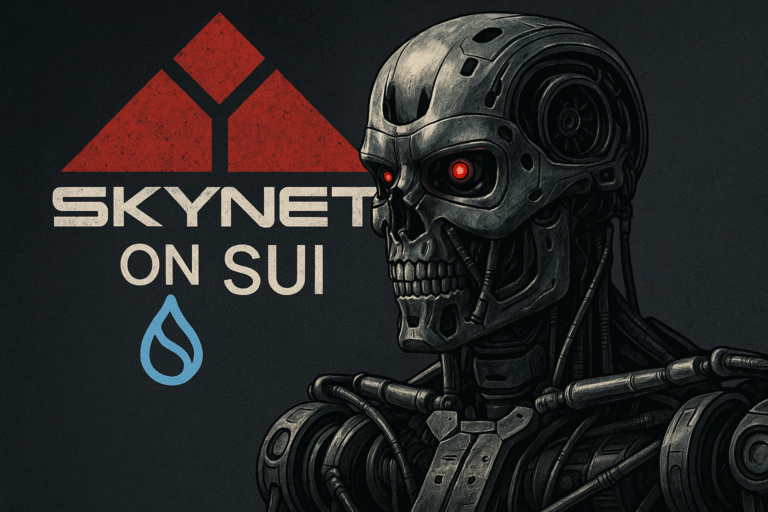Artificial intelligence is transforming the way we discover, make decisions, and deliver value online. Blockchains are transforming how we coordinate, prove ownership, and transfer assets. However, until recently, AI and Web3 have existed mainly in separate worlds. Skynet on Sui brings them together with a practical vision: AI agents that live on-chain yet can talk to the real world, retrieve off-chain data, trigger actions across smart contracts, and execute end-to-end business logic with verifiable security. The result is a new class of on-chain AI agents that are not just clever copilots, but accountable counterparts—programmable actors that can observe, decide, and act while preserving transparency, auditability, and user control.
In this deep dive, we’ll explore what Skynet on Sui is, why agentic AI requires real-world interfaces, how the architecture integrates decentralized AI with Sui’s object-centric design, and which use cases are likely to reach escape velocity first. We’ll also cover developer workflows, performance considerations, risks, and how builders can get started creating reliable AI agents on Sui today.
What Is Skynet on Sui?
Skynet on Sui is an initiative focused on building AI agents that run on or are orchestrated by the Sui blockchain, a high-throughput, low-latency L1 known for its parallelized execution and object model. These agents can interact with on-chain resources, call out to oracles or verified off-chain compute, and then commit results back to the ledger. Unlike traditional bots that operate in black boxes, Skynet’s agents are instrumented to provide provable state transitions, verifiable data provenance, and on-chain receipts for critical decisions.
At its core, the promise is simple: pair the reasoning power of AI with the determinism, composability, and security of Sui. That marriage enables trustable automation—for example, an agent can read real-time market data, decide whether to rebalance a DeFi portfolio, execute a transaction, and log the full decision trail on-chain.
Why Sui?
Sui’s architecture was designed for speed, scalability, and an elegant developer experience. Its Move language and object-centric model allow fine-grained control of digital assets. For AI agents that need to handle numerous small interactions—such as reading states, updating positions, and posting attestations—Sui’s parallel execution and rapid finality provide a robust foundation. In short, the chain’s performance profile suits agentic workflows that require both speed and transparency.
Why AI Agents Need Real-World Interfaces

AI agents are only as helpful as the context they can perceive and the levers they can pull. An agent that cannot sense real-world data is like a pilot flying blind; one that cannot trigger external actions is a mere commentator. Skynet’s approach gives agents the ability to safely:
Observe: Pull In Signals From Off-Chain Sources
Agents ingest market price feeds, IoT telemetry, web APIs, and enterprise datasets through verified connectors. By tethering these inputs to tamper-evident oracles and cryptographic attestations, Skynet reduces the trust surface while preserving the richness of off-chain context. This lets agents go beyond static on-chain snapshots and reason about live conditions.
Decide: Reason With Context and Policy
Using a mix of LLMs, tool-use frameworks, and policy engines, agents transform observations into decisions. Crucially, Skynet emphasizes guardrails—structured prompts, constraints, and privacy-preserving execution so agents remain aligned with user intent. The decision logic, inputs, and outputs can be recorded as on-chain artifacts for audit and replay.
Act: Execute Transactions and Off-Chain Calls
Finally, agents take action: posting smart contract calls, transferring assets, adjusting parameters, or triggering off-chain services, such as logistics updates or compliance checks. Each action produces evidence—such as transaction hashes, signed messages, or proofs—so stakeholders can verify not only the result but also the reasoning path that led to it.
Architecture: On-Chain Agents With Off-Chain Intelligence
Skynet on Sui blends three layers: on-chain orchestration, off-chain intelligence, and verified integration.
On-Chain Orchestration
On-chain components define agent identities, permissions, and capability objects in Sui. They also maintain registries for tools, connectors, and policies. This layer answers questions like: Which data sources is an agent allowed to query? Which contracts can it call? What spending or rate limits apply? Because these rules live on-chain, they are transparent and composable.
Off-Chain Intelligence
The agent’s reasoning loop typically runs off-chain for cost and performance, but on-chain checkpoints anchor it. Think of this as a co-processor model: the agent plans, tools, and calls external APIs, then returns a signed, structured result to the chain. Where needed, zero-knowledge proofs or trusted execution attestations provide assurances that sensitive computations occurred as claimed—a pragmatic path to privacy-preserving AI.
Verified Integration
Data and action bridges are the arteries of the system. Skynet utilizes oracles, attestation services, and cryptographic proofs, enabling the chain to trust what it sees without relying on opaque intermediaries. Each connector is versioned, permissioned, and monitored for security. If a feed degrades or a provider changes terms, agents can fail gracefully, switch providers, or require human review.
Prime Use Cases That Benefit First
Skynet on Sui supports a wide range of applications, but a few verticals are particularly well-suited for AI agents that interact with the real world.
Autonomous DeFi Treasury and Risk

Treasuries and DAOs often juggle liquidity, yield, and risk across protocols. Skynet agents can read volatility, funding rates, and liquidity depth, then recommend or execute rebalances within predefined limits. They can also post risk dashboards on-chain, with contextual notes and source receipts, enabling lightweight, continuous governance.
Commerce, Subscriptions, and Settlements
In Web3 commerce, the last mile—encompassing billing, dispute resolution, and refund logic—is often a complex process. Agents can monitor usage, detect anomalies, and settle payments based on service-level events. For recurring subscriptions, an agent can verify off-chain consumption, calculate prorations, and post NFT receipt objects that serve as both warranties and proofs of service.
Supply Chain and IoT Attestations
IoT sensors generate abundant but noisy data. Agents can filter signals, identify exceptions, and write on-chain attestations linked to shipments or components. When a temperature spike jeopardizes cold-chain integrity, an agent can notify logistics partners and adjust escrow conditions accordingly, depending on compliance thresholds.
Gaming and Dynamic Assets
In games and metaverse experiences, dynamic NFTs gain value from narrative context and off-chain events. Agents can pull in tournament results, social trends, or creator updates to evolve assets, adjust rarity mechanics, and distribute rewards. The on-chain audit trail ensures a fair and replayable economy.
Security, Privacy, and Compliance by Design
Any system that connects on-chain capital to off-chain signals must take security seriously. Skynet’s approach layers defense-in-depth:
Strong Identity and Permissions
Agents hold minimal privileges, encoded in capability objects. Spending limits, rate limits, and per-tool scopes are enforced on-chain. Developers can require multisig approvals, time locks, or guard contracts for sensitive operations. This principle of least privilege sharply reduces blast radius.
Data Provenance and Auditable Trails
Every critical decision leaves a verifiable trail: which data sources were consulted, which prompts and tools were used, and which policies were in effect. Agents can attach hashes, signed statements, or zk commitments to their outputs. Auditors can later reconstruct the decision path without seeing sensitive raw inputs, balancing accountability with privacy.
Privacy-Preserving Execution
When agents must process confidential inputs—such as proprietary price curves, user PII, or regulated data—Skynet favors confidential computing and zero-knowledge protocols. The chain gets proof of validity, not the data itself. This enables compliance-aware automation in sectors such as fintech and healthcare, where trust and privacy are of paramount importance.
Developer Experience: From Idea to Agent
Building on Skynet on Sui follows a clean developer mental model: define capabilities, compose tools, write policies, and test end-to-end.
Capability-First Design
Begin by clearly stating what your agent can and cannot do. Capabilities might include read-only market data, ERC-20-like transfers, or contract-specific calls. By shaping capabilities first, you ensure autonomy lives inside guardrails, not outside them.
Tooling and Connectors
Next, bind tools such as price feeds, KYC/AML checks, shipping APIs, or analytics endpoints. Each tool returns structured results and includes a health metric. Agents degrade gracefully: if Tool A is down, fall back to Tool B, or escalate to a human.
Policy and Guardrails
Policies encode risk limits, escalation paths, and human-in-the-loop handoffs. For example, an agent may self-approve trades under a notional threshold but require signature collection for larger exposures. Policies can be versioned and rolled out with canaries, just like modern software.
Testing and Simulation
Before going live, simulate with a forked chain state and synthetic data to ensure accuracy and reliability. Record playbacks to hone prompts, evaluate hallucination resistance, and verify latency budgets. The goal is predictable behavior under stress and drift.
Performance and Cost Considerations
Agents need to be responsive without incurring excessive costs. Skynet’s co-processor architecture helps balance:
Latency Budgets
Most real-world actions are near-real-time, not nanosecond HFT. Aim for a tiered SLA: sub-second for reads and internal reasoning; seconds for cross-chain or settlement writes. Cache immutable data, batch writes, and use idempotent patterns to avoid double-spends.
Cost Controls
Utilize off-chain inference with on-chain anchoring to maintain predictable gas and computation costs. Aggregate low-value signals off-chain, post only decisive evidence on-chain, and prune logs to Merkle summaries when detailed replay isn’t needed.
How Skynet on Sui Compares to Other Approaches
The broader ecosystem is experimenting with autonomous agents, decentralized inference, and oracle-driven automation. Skynet’s distinguishing attributes are its tight coupling with Sui’s object model, performance at scale, and a practical blend of verifiability and privacy. Some frameworks push all logic on-chain (costly), while others keep everything off-chain (opaque). Skynet’s hybrid model offers builders the best of both worlds: speed and flexibility, along with on-chain accountability where it matters.
Challenges and Open Questions
No platform is perfect, and responsible teams acknowledge its imperfections.
Robustness and Hallucination
LLMs can still misinterpret vague prompts or produce overconfident outputs. Skynet mitigates risks with tool-grounded reasoning, structured outputs, and policy checks, but builders must measure and monitor these outcomes. Wherever possible, replace open-ended generation with function calls that have explicit schemas.
Data Integrity and Oracle Risk
All external data introduces trust assumptions. Even with attestations, a compromised provider can mislead agents. The antidotes are redundancy, cross-checks, safeguards against malicious behavior, and circuit breakers that pause automation when feeds diverge beyond predetermined thresholds.
Regulatory Flux
As AI and crypto regulations evolve, compliance rules will change. Skynet’s policy engine should make it straightforward to update KYC, AML, and record-keeping requirements without requiring the rewriting of agent logic.
The Impact: From Bots to Accountable Counterparts
When AI agents become accountable actors—with permissions, proofs, and policies—they unlock a new class of user experiences. A small startup can ship services that feel like a 24/7 operations team. A DAO can run like a modern treasury desk. A supply chain can detect tamper-evident compliance in real-time. Skynet on Sui isn’t just about clever bots; it’s about reliable automation people can trust.
Getting Started: A Practical Path for Builders
If you’re evaluating Skynet on Sui for your product, start with a thin slice where automation creates obvious value while carrying bounded risk. Map the data sources, write your policies, and stand up a single agent with a narrow scope. Instrument everything. Once you can prove value—fewer manual steps, tighter risk control, faster settlement—expand to more tools and permissions. Keep humans in the loop where judgment matters, and let agents handle the repetitive coordination work that often bog down teams.
Conclusion
Skynet on Sui is a compelling blueprint for AI agents that aren’t trapped in sandboxes. By combining Sui’s performance and object-centric design with verified off-chain intelligence, Skynet enables agents that can observe, decide, and act—with verifiable trails, strong privacy, and sensible guardrails. Whether you’re in DeFi, commerce, IoT, or gaming, the pattern is the same: connect trusted signals to programmable actions, and give users automation they can audit, not just admire. The future of decentralized AI will belong to platforms that make intelligence actionable, accountable, and composable—and Skynet on Sui sits squarely in that lane.
FAQs
Q: What makes Skynet on Sui different from typical AI bots?
Skynet’s agents aren’t just chatty interfaces. They have tightly scoped on-chain permissions, verifiable data provenance, and policy-enforced guardrails. They can read real-world data, take smart contract actions, and leave audit trails, turning AI from a suggestion engine into a trustworthy executor.
Q: Can Skynet agents operate entirely on-chain?
For small tasks, yes—but most real deployments use a hybrid model: off-chain reasoning for speed and cost, with on-chain checkpoints for accountability. Sensitive logic can leverage zero-knowledge or confidential computing to maintain the privacy of private data while ensuring correctness.
Q: How do agents avoid making bad or unsafe decisions?
Through layered safety: minimal capabilities, explicit policies, structured tool use, and human-in-the-loop escalation for high-impact actions. Health checks and circuit breakers pause automation if data feeds disagree or markets behave abnormally.
Q: Which industries will benefit the most first?
Early adopters are likely DeFi treasuries, Web3 commerce, supply chain/IoT, and gaming—domains where on-chain settlement meets rich off-chain context, and where continuous, verifiable automation creates immediate value.
Q: How should a team start building with Skynet on Sui?
Select a narrow, high-ROI workflow—such as automated rebalancing or subscription settlement—define its capabilities and policies, integrate a small set of oracles and tools, and run controlled pilots. Measure outcomes, expand permissions gradually, and maintain auditability as a top priority.
Also Read: Sui Network Explained: How This Fast Blockchain is Changing DeFi Forever

